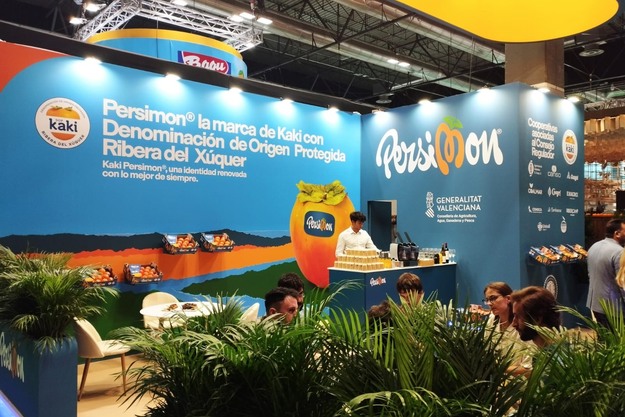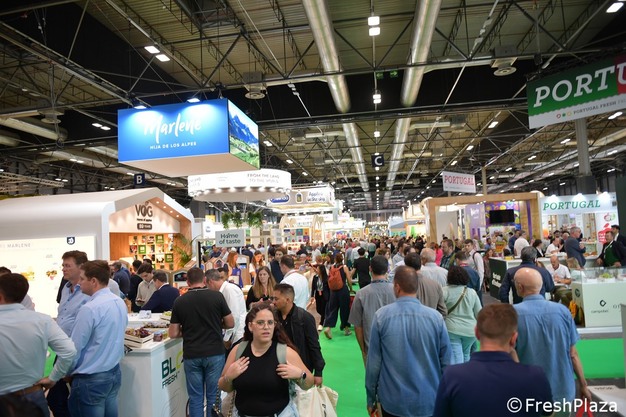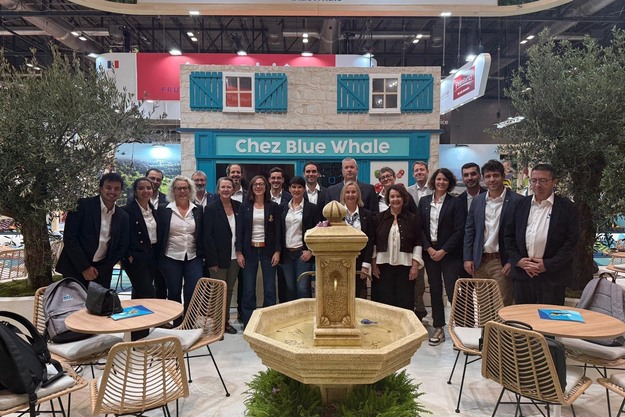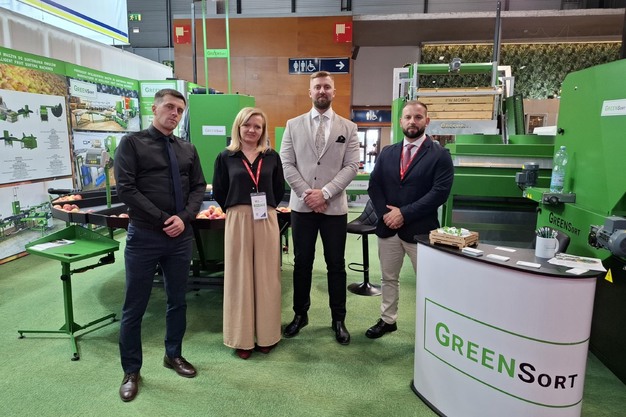Tuesday saw the opening day of this year's Fruit Attraction trade show in Madrid. The biggest edition so far, with 10% more exhibiting space and 8,4% more exhibitors. Due to traffic jams, the show wasn't very busy until noon. The event is bigger this time with two new halls, although the occupants seem to be less than happy with the positioning. Others have been very happy with the first day; some said it was busier than previous years, but traditionally, the second day is the busiest.
Stand holders find it a great way to talk to customers and plan sales programs for the coming seasons. There have also been discussions on new regulations within the EU.
 © Joel Pitarch | FreshPlaza.com
© Joel Pitarch | FreshPlaza.com
The Kaki Persimon stand
Spain
In general, people talk about how production costs are high and it's difficult to make profits in almost every product. The greenhouse vegetable season is kicking off now, as well as citrus, which makes halls with companies that grow and trade such products especially busy.
Spanish growers are talking about the small citrus harvest this year; there is a big overlap with mandarins from South Africa. So Spanish growers are waiting to start their campaigns for real. Pepper growers are very concerned about thrips parvispinus among other viruses.
Mangoes, though, are doing badly because of a big production and bad planning with European retailers. Growers are already looking towards the coming avocado season, which will start in November.
 © Nichola McGregor | FreshPlaza.com
© Nichola McGregor | FreshPlaza.com
The busy Peruvian stand
The Americas
The Americas pavilion played a prominent role at Fruit Attraction, bringing together countries such as Ecuador, Argentina, Panama, Costa Rica, the Dominican Republic, Chile, Brazil, Colombia, Peru, Mexico, and Uruguay. The joint presence of these nations reflected the region's growing importance in the supply of fruits and vegetables to Europe.
The diversity of products presented—from mangoes, papayas, and melons to grapes, avocados, bananas, and citrus fruits—demonstrated the breadth of the Latin American and Caribbean offering. At the same time, many of the discussions revolved around the standards required by the European market, such as food safety certifications (GlobalGAP, GRASP), traceability, social responsibility (SMETA), and environmental sustainability.
The pavilion provided a glimpse not only into the competitiveness of each country but also into how exporters are seeking to adapt to increasingly stringent requirements from international buyers, in order to ensure their presence and growth in key destinations.
 © Nichola McGregor | FreshPlaza.com
© Nichola McGregor | FreshPlaza.com
The team at Beenkenkamp
The Netherlands
There was a large Dutch delegation at Fruit Attraction. Besides some traffic problems before the show, people are happy with the first day. The first day was not super busy, but there was a continuous flow of visitors. Standholders said that mango and avocado yields in Spain are high for the first time in years. Also, Spanish mandarins and greenhouse vegetables are already finding their way to the Netherlands. They see this show as the deal moment to make contracts with suppliers. On the social side, this evening, a lot of fresh produce traders will go to the Atletico Champions League. Tomorrow, they expect the busiest day at the fair, as tradition.
Belgium
A new hall for the Belgians this year, who are mainly located in Hall 4. Nevertheless, there is optimism about the foot traffic on the first morning. The Italians, located right next to the Flemish pavilion, are drawing a large crowd. Fruit Attraction seems to be becoming an increasingly important trade fair for Belgian exhibitors each year. With the top fruit harvest done, there is optimism for the Belgian pears this year, but apples seem to be a bit concerning.
 © Cristiano Riciputi | FreshPlaza.com
© Cristiano Riciputi | FreshPlaza.com
Italy
For Italian traders, a trade fair such as Fruit Attraction presents an opportunity for planning. "Every fair is also an opportunity to establish long-lasting relationships with buyers," says Luca Canonici of the Sapore di Romagna cooperative. "You cannot produce without having a clear idea of your sales channel. Planning is essential not only at the company level, but also for the country as a whole."
"Planning with foreign markets is crucial, even at this stage," says Gerardo Diana, president of the Arancia Rossa di Sicilia Consortium. "International markets are vital for us because they are growing. Some, such as France, demand quality products, even better if they are PGI. Clearly, we need a cultural shift: we must invest in overseas communication to promote not only fresh produce, but also processed products like those we showcased at the fair."
Plant nurseries are also a source of innovation and exports. This is confirmed by Enrico Mazzon of Top Plant: "The majority of our turnover comes from abroad. For example, the cherry trees we produce are sold far more overseas than in Italy, in regions such as Eastern and Northern Europe."
 © Nichola McGregor | FreshPlaza.com
© Nichola McGregor | FreshPlaza.com
The Blue Whale team
France
French exhibitors were very happy with the first day. In addition to higher attendance compared to last year, many said that the contacts they made led to contracts being signed. Cooperatives and producers were delighted to see supermarket buyers in attendance, with all the major chains represented. The general feeling is that Madrid gets better every year. There were several new French exhibitors. Some took advantage of Fruit Attraction to announce crop diversification, packaging plant expansion, or the launch of new varieties, such as the new Kiara pear. Discussions among producers also focused heavily on agricultural protests and the difficulties encountered by French industries, particularly in relation to unfair competition with other countries in the European Union (pesticides), as France has some of the strictest regulations.
Northern Africa
Participation from North Africa is again dominated by Egyptian and Moroccan exhibitors, which are located in Hall 14 alongside other African and Asian origins, a hall that is "disconnected from the flow of traffic at the fair", according to many exhibitors. Several exhibitors from the two countries have made no secret of their dissatisfaction with this location, which they consider marginalized and inconsistent with the importance of Egypt and Morocco in terms of fresh produce trade volumes and value. An Egyptian exporter said, "We have been placed, along with our Moroccan counterparts, outside the main flow of the fair despite the great importance of our respective origins for the global fresh produce market. We have had traffic, but these are regular visitors or leads already acquired before the fair. The decision to change the location of the hall dedicated to the MENA region this year is very regrettable and raises questions about its intentions." A Moroccan exhibitor said, "This is the worst stand and the worst location we have been given in more than a decade of regular participation in the fair. It seems that Hall 14 is dedicated to the "third world" in a mindset that does not reflect the importance of fresh produce exporting countries to the global market."
The fair's side events program also drew criticism from Moroccan professionals. One visitor said, "We see that discussions are taking place on the sidelines of the fair that directly concern Moroccan exports to Europe, particularly tomatoes, and where the floor is given entirely to the competition. The exclusion of Moroccan speakers adds to a spatial marginalization in terms of the location of the stands and the hall."
However, the 2025 edition of Fruit Attraction saw greater diversification in participation from the MENA region. The Lebanese pavilion returned after a forced absence due to political conditions in the country last year. The Mauritanian pavilion is now a regular feature of the fair, and this year also saw the first installation of an Algerian pavilion.
 © Nichola McGregor | FreshPlaza.com
© Nichola McGregor | FreshPlaza.com
The team at GreenSort
Poland
The Polish apple exporters are also feeling the lower volumes of Turkish apples, as there is a lot of demand from India this year. Overall, it looks to be a good apple season, with better volumes than last year.
Turkey
The Turkish stands do not appear to be very happy with the new hall, either, as they have been placed in Hall 14. They stated there was less traffic than they anticipated. They also had a rough season, with many fruits having a lower production this year, and some trees still feeling the effects of the frost of 2024.
 © Nichola McGregor | FreshPlaza.com
© Nichola McGregor | FreshPlaza.com
The Fresh Formulaics team
North America
Fruit Attraction is becoming increasingly well-known in North America, and more and more companies send representatives to walk the show floor. However, the number of exhibitors from the continent is still relatively low and is mainly made up of companies with a global presence involved in breeding, packaging, labeling, and shelf-life extension. In addition, providers of ethylene, measuring instruments, retractable roof systems, and temperature tracking devices are exhibiting. The share of growers and shippers is small because very few fresh produce items are exported from North America to Europe nowadays. One sweet potato exhibitor mentioned that the growing environment in the U.S. is harsh. Input costs such as labor, fertilizers, and farming equipment have increased significantly, and growers are looking for ways to recoup their investments, which is becoming increasingly tough.
